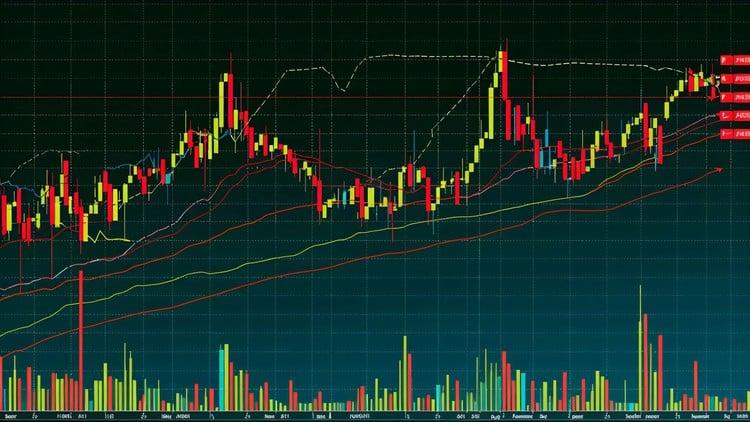1 - Introduction to CMT Level 1 Prep Course
2 - Line Chart and Bar Chart
3 - Candlestick Chart and Pitfall
4 - Pitfall Candlestick Concluded
5 - Dow Theory
6 - Support and Resistance
7 - More Details On Support and Resistance
8 - Types of candlestick Patterns
9 - Practicals of Short and Long Candlestick Patterns
10 - Types of Doji Candlestick Patterns
11 - Long Upper and Lower Shadows
12 - Long Lower Shadows Only
13 - Introducation to Reversal Patterns
14 - Continuation of Head and Shoulder Top
15 - Head and Shoulder Top Psychology
16 - Variations and Facts of H and S Top
17 - Features and Characteristics of Head and Shoulder
18 - Learn Double Bottom
19 - DB Psychology and Volume
20 - Four Types of Double Bottom
21 - Market with Alphabets Double Bottom
22 - Continue on Market Alphabets Double Bottom
23 - Triple Bottom Introduction
24 - Triple Bottom Variations
25 - Triple Bottom Psychology and volume
26 - Triple Bottom Exercise
27 - Learn Double Top
28 - Double Tops R Com Chart
29 - Four Types of Double Tops
30 - Understanding Variations
31 - Facts of Double Tops
32 - Identifying Double Tops
33 - Triple Top TT
34 - Triple Tops Psychology and Volume
35 - Triple Tops Psychology and Volume Continue
36 - Rising wedge
37 - Falling Wedge
38 - Minor High
39 - Minor Lows
40 - Trendline and Channels
41 - Slope of Trendline
42 - Linear and Logarithmic Scale
43 - Types of Trendlines
44 - Importance of Trendlines
45 - Trend Channels
46 - Introduction to Rectangle Pattern
47 - Explained Different Concepts with Chart
48 - Different Concepts with Chart Continues
49 - Variation and Exercise
50 - Variation and Exercise Continue
51 - Ascending Triangle
52 - Important Point of Ascending Triangle
53 - Ascending Pyschology and Exercise
54 - Pyschology and Exercise Continues
55 - Introduction to Descending Triangle
56 - Explained Different Concept with Chart
57 - Different Concept with Chart Continues
58 - Daily Pattern Char
59 - Introduction to Symmetrical Triangle
60 - Symmetrical Triangle Psychology
61 - Different concept of Symmetrical Triangle
62 - Symmetrical Triangle Exercise
63 - Introduction to Flag
64 - Falg and Penants
65 - More on Falg and Penants
66 - Important Points of Flag
67 - Exercise Penants
68 - Introduction to GAP
69 - Explain Gap up and Gap Down
70 - Common Gap
71 - Practical Implication with Chart
72 - Breakaway Gap
73 - Breakaway Gap with implication with Chart
74 - Runaway Gap and Continuation Gap
75 - Runaway Gap implication with Chart
76 - Exhaustion Gap
77 - More on Exhaustion Gap
78 - Exhaustion Gap Implication with Chart
79 - Two Types of Technical Analysis
80 - Introduction to Momentum Oscillator
81 - More on Momentum Oscillator
82 - Leading and lagging Indicator Explained
83 - Leading and lagging Indicator Explained Continues
84 - Relative Strength Index
85 - Overbought and Over Sold Explanation
86 - Explained Divergence
87 - Explanation on chart and Exercise
88 - Introduction to Moving Average MA
89 - Explanation on chart MA
90 - Exponential Moving Average
91 - Elements of MACD
92 - Explanation on chart MACD
93 - MACD Crossover
94 - MACD Divergences
95 - Stochastic Oscillator
96 - Stochastic Formula
97 - Ranging Markets
98 - Stochastic Oscillator Different Concept
99 - Stochastic Oscillator Chart
100 - Money Flow Introduction and Explanation
101 - Money Flow index Introduction and Explanation
102 - Money Flow index Explain Formula on Excel
103 - Money Flow index Explanation on Charts
104 - Money Flow index Explanation of Failure Swing on Chart
105 - Explain Accumulation Distribution
106 - Accumulation Distribution Formula
107 - Formula and Practical Chart
108 - Introduction to Chaikin Money Flow
109 - Chaikin Money Flow Calculation
110 - Practical Implication on Chart
111 - Chart Explanation Continues
112 - Explanation of Ichimoku Cloud
113 - Analyzing Trend
114 - Analyzing Uptrend
115 - Ichimoku Cloud Downtrend
116 - Identifying Trend
117 - Practical chart Implication
118 - Practical chart Implication Continues
119 - Explain On Balance Volume
120 - Balance Volume Interpretation
121 - Characteristic of OBV
122 - Trading Signals
123 - Practical Explanation on Chart
124 - Practical Explanation on Chart Continues
125 - What is Volatility
126 - Implied Volatility
127 - Implied Volatility Continues
128 - Explain Put Call Parity
129 - Put and Call Option
130 - Explain Put Call Parity with Table
131 - Explain Put Call Parity with Table Continues
132 - Explain Pricing Calculators
133 - Pricing Calculators and Other Tools
134 - Fluctuations Based on Supply and Demand
135 - Fluctuations Based on Supply and Demand Continues
136 - Impact on Option Prices
137 - Implied Volatility and option Prices
138 - VIX Introduction and Explanation
139 - Explain VIX and PutCall Parity
140 - Explain VIX and PutCall Parity Continue
141 - VIX VIX and Market Movement
142 - VIX VIX and Market Movement Continue
143 - Open Interest Introduction and Explanation
144 - Open Interest Crowd Psychology and Trading Rules
145 - Open Interest and Implied volatility Live Example
146 - Introduction to Wave Principle
147 - Wave Principle Explanation
148 - Corrective Phase
149 - Important Rules of Elliott Wave
150 - Impulse Pattern
151 - Elliott Wave Degree
152 - Explain Complete Market Cycle
153 - Explain Extension
154 - Different Types of Extension
155 - Third and Fifth Wave Extension
156 - Third and Fifth Wave Extension Continue
157 - Ending Diagonal
158 - Leading Diagonal
159 - Fibonacci Numbers
160 - Fibonacci Retracement
161 - Fibonacci Retracement Continues
162 - Corrective Waves
163 - Corrective waves Continue
164 - Double ZigZag
165 - Irregular Expanded Flat
166 - Running Flat
167 - Triangle and Combination
168 - Triangle and Combination Continues
169 - Explain Fibonacci Relationship
170 - Explain Fibonacci Relationship Continues
171 - Fibonacci Multiple for Flats
172 - Expanded Flats
173 - Explain Anatomy Elliott Wave Trading
174 - Improve Trading Through Elliott Wave
175 - Improve Trading Through EW Continues
176 - Determining Maturity of Trend
177 - Providing Specific Points Invalidation
178 - Four Best Waves to Trade
179 - Trade on Break of Patterns
180 - Trade on Break of Patterns Continues
181 - Ending Diagonal 1
182 - Aggressive Approach Break of Zigzag
183 - Triangle Pattern
184 - Risk Management
185 - The Psychology of Trading
186 - Explain Basic of EMH
187 - What is EMH
188 - Strong form of the EMH
189 - Random Walk and Martingale Hypothesis
190 - Expected Future Stock Price
191 - Characteristics and Construction
192 - Point and Figure Chart
193 - Point and Figure Chart Continues
194 - Explain 1 Box Reversal Chart
195 - More on 1 Box Reversal Chart
196 - Explain 1 Box and 3 Box Reversal Chart
197 - 3 Box Reversal Chart Continues
198 - Explain 5 Box and 2 Reversal Chart
199 - Point and Figure Chart Formation
200 - Trendline on Point and Figure Chart
201 - Point and Figure Trading Techniques
202 - Horizontal Count
203 - Vertical Count
204 - Explain Risk and Return
205 - The CAPM Equation
206 - The CAPM Equation Continues
207 - Seasonality and Calendar Patterns
208 - Explain Seasonality
209 - Explain Seasonal Pattern
210 - Cycle Analysis and Basics
211 - Understand Business Cycle
212 - The Kondratieff Wave
213 - Revision of Dow Theory and Candlestick Patterns
214 - Reversal Patterns
215 - Reversal Patterns and Trendline and Channels
216 - Revision of Continuation Patterns
217 - Understand Indicators
218 - Money Flow
219 - Understanding Volatility and its Types
220 - Introduction to the Wave Principle
221 - Elliott Wave and Fibonacci
222 - Anatomy of Elliott Wave Trading
223 - Practice on Live Charts
224 - Practice on Live Charts Continues
225 - Identifying Patterns Using Live Chats













